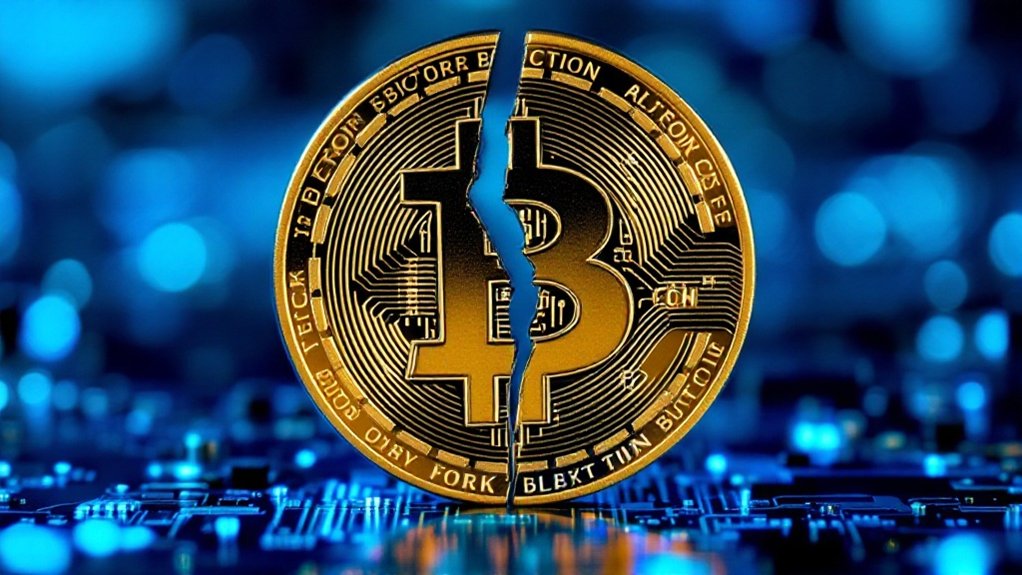Solana is a high-speed blockchain platform utilizing Proof of History consensus to process transactions at scale. It supports DeFi applications, NFT marketplaces, and decentralized apps with transaction speeds significantly faster than traditional blockchains. SOL tokens serve as the network's currency for fees, staking, and governance rights. With a developer-friendly ecosystem primarily using Rust, Solana positions itself for substantial growth through 2025, targeting theoretical capabilities of up to 1 million TPS. Further exploration reveals its comprehensive blockchain innovation strategy.

SOL, Solana's native cryptocurrency, serves multiple critical functions within the ecosystem. It acts as the payment mechanism for transaction fees, enables participation in network staking, and provides governance rights for protocol decisions. The token operates under an inflationary model with a decreasing issuance rate, maintaining a circulating supply of approximately 470 million SOL.
The Solana ecosystem encompasses diverse applications across decentralized finance, NFT marketplaces, and scalable decentralized applications. Its compatibility with Solana Mobile improves Web3 accessibility for mainstream users. The integration of PayPal USD stablecoin demonstrates growing institutional confidence in the platform. Developers benefit from a robust toolkit supporting multiple programming languages, with particular emphasis on Rust, allowing for efficient smart contract deployment and seamless integration with existing projects.
Looking toward 2025, Solana is positioned for continued expansion in its user base and transaction volume. Industry analysts anticipate improvements to staking economics, governance structures, and cross-chain interoperability. The platform's energy efficiency compared to Proof-of-Work blockchains aligns with growing environmental concerns in the cryptocurrency sector. Price predictions suggest SOL could reach maximum of $212.74 by May 2025, reflecting strong growth potential.
The future development roadmap includes scaling capabilities toward the theoretical maximum of 1 million TPS, further reducing transaction costs, and strengthening network resilience.
Solana's commitment to performance optimization while maintaining decentralization principles establishes its position as a leading infrastructure provider for next-generation blockchain applications. As adoption increases, the platform continues to attract developers seeking high throughput, low latency, and cost-effective blockchain solutions.
Frequently Asked Questions
How Does Solana Compare to Ethereum for NFT Creators?
Solana offers NFT creators significant advantages over Ethereum in transaction speed and cost efficiency.
With 2,600+ TPS compared to Ethereum's 15-30 TPS, Solana enables faster minting and trading. The platform's $0.00025 transaction fee is dramatically lower than Ethereum's $0.30-$10+ gas fees.
While Ethereum boasts a larger ecosystem with established marketplaces and blue-chip collections, Solana's growing ecosystem is increasingly attractive for gaming NFTs and PFP collections.
Can Solana Smart Contracts Be Audited Like Ethereum's?
Solana smart contracts can be audited similar to Ethereum's, though with platform-specific focus.
Qualified firms like Kudelski Security, CertiK, and Halborn offer specialized Solana contract verification services.
The audit process includes manual code reviews, automated vulnerability scanning, and simulated attacks.
However, Solana audits emphasize Rust language specifics rather than Solidity, account model evaluations, and proper validation of program derived addresses (PDAs).
Cross-program interactions receive particular scrutiny due to Solana's architecture.
What Hardware Is Required to Run a Solana Validator?
Running a Solana validator requires robust hardware specifications.
Nodes need at least 12 cores/24 threads (16 cores/32 threads for RPC nodes) with 2.8GHz base clock speed and AVX2 instruction support.
RAM requirements start at 256GB for consensus validators and 512GB for RPC nodes.
Storage demands include high-endurance PCIe Gen3 x4 NVMe SSDs totaling over 2TB across accounts, ledger, and snapshots.
A 1 Gbps symmetric internet connection is necessary, with 10 Gbps preferred.
How Does Solana Prevent MEV Attacks?
Solana prevents MEV attacks through multiple architectural features and ecosystem initiatives.
Its lack of mempool reduces attack surfaces, while the Jito Foundation blacklists malicious validators.
The platform implements dynamic slippage protection and MEV-resistant AMM designs like Ellipsis Labs' Plasma.
Jupiter Aggregator's MEV Protect Mode routes transactions to Jito block engines.
Additionally, Solana's leader-follower validator structure inherently limits opportunities for transaction manipulation that typically enable MEV extraction.
Will Solana Implement Sharding in Its Future Roadmap?
Solana currently has no official plans to implement sharding in its future roadmap.
The network already achieves high transaction throughput (65,000+ TPS) using its existing architecture based on Proof of History.
Instead, Solana focuses on alternative scaling solutions including the Firedancer validator client, state compression techniques, and potential layer-2 solutions.
Implementing sharding would require significant architectural changes that might compromise Solana's current performance advantages and introduce additional complexity.
References
- https://changelly.com/blog/solana-price-prediction/
- https://www.coinmetro.com/learning-lab/understanding-solana-a-beginners-guide
- https://changelly.com/blog/solana-review/
- https://osl.com/en/academy/article/understanding-solanas-staking-and-validator-economics-in-2025
- https://changehero.io/blog/what-is-solana/
- https://zebpay.com/blog/top-10-solana-projects-of-2025
- https://tokentax.co/blog/solana
- https://www.bitcoinsensus.com/learn/solana-in-2025-still-a-leader-in-fast-blockchain-technology/
- https://osl.com/academy/article/understanding-solanas-staking-and-validator-economics-in-2025/
- https://www.investopedia.com/solana-5210472





